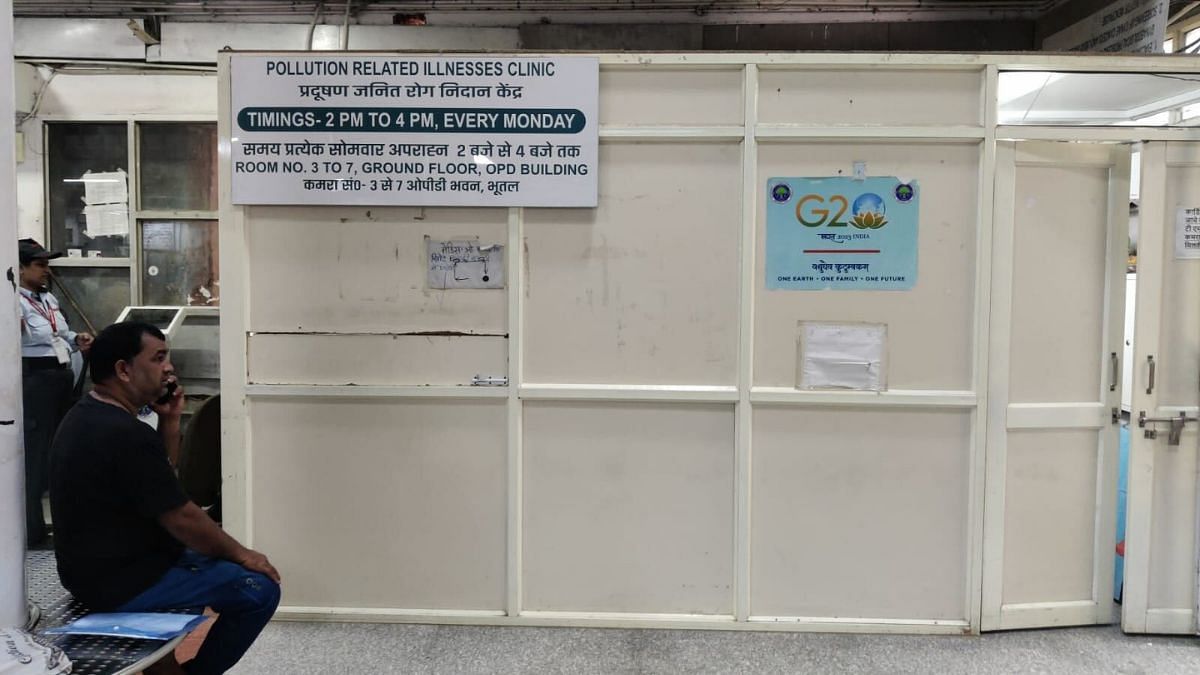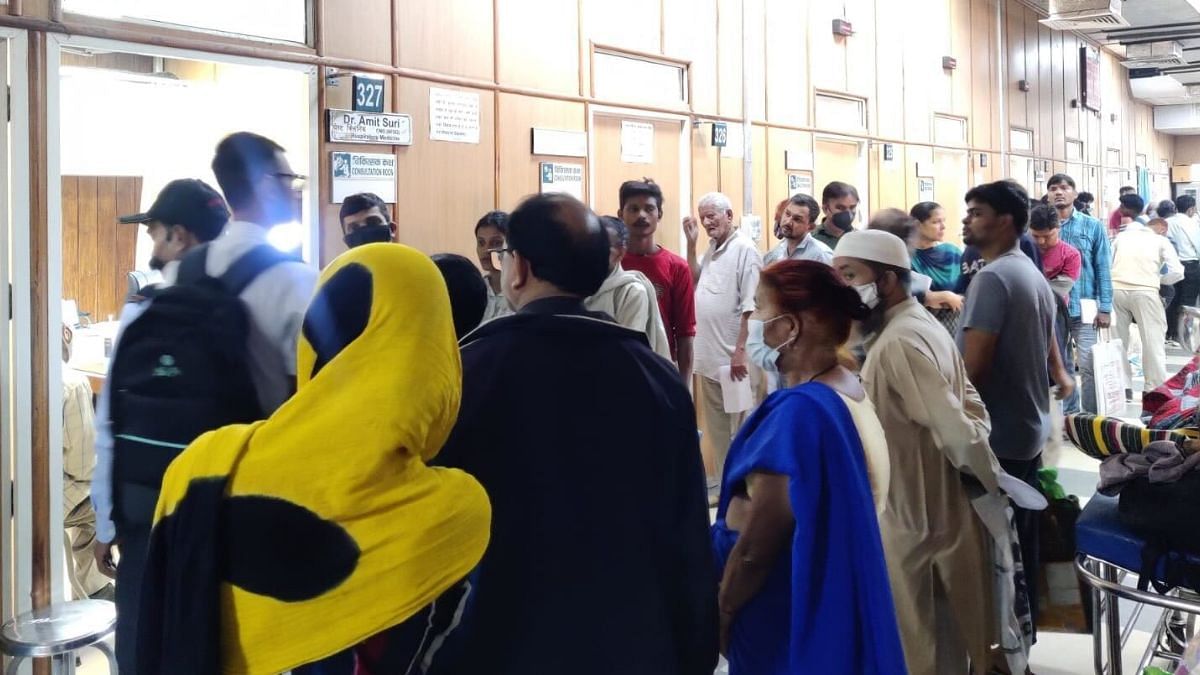New Delhi: Delhi’s annual tryst with air pollution during the winter months brings a litany of ailments: dry persistent coughs, bronchitis, upper respiratory infections, and pneumonia. According to doctors, cases in pulmonary and respiratory outpatient departments (OPDs) at both public and private hospitals have surged over the past two weeks, including among healthy individuals.
Doctors at Fortis Hospital, Delhi, claim to have seen a 20-25 percent increase in the number of patients with pollution-related illnesses. Dr Vikas Maurya, senior director and head of respiratory medicine and interventional pulmonology, told ThePrint, “These are typically healthy individuals who remain fit throughout the year but develop these conditions, particularly in the winter months, when AQI levels in the city rise.”
Delhi’s Ram Manohar Lohia Hospital (RML), which launched its Air Pollution OPD in November last year, only began receiving patients after 14 October this year, once pollution levels started rising. Since then, they have been seeing about 10-12 patients per week.
Dr Ankit Pandey, a senior resident doctor in the RML’s pulmonary medicine department, further added, “Before Diwali, the pulmonary medicine OPD, held on Tuesdays and Thursdays, saw around 200 patients per week. Now, this number has risen to 250-300 patients.”
On Wednesday, the situation remained dire with Delhi’s AQI remaining in the ‘very poor’ category for the 15th consecutive day since Diwali.
Doctors across public and private hospitals also reported the exacerbation of respiratory symptoms in patients with pre-existing chronic conditions such as asthma, chronic obstructive pulmonary disease (COPD), or other chronic lung conditions. They advise at-risk groups—children under five, the elderly, and those who suffer from chronic illnesses—to leave Delhi for the winter months.

The problem is even more pressing for those who work outdoors. Dr Amit Suri, head of the respiratory medicine department at RML Hospital, told ThePrint, “Our pollution clinics and the respiratory medicine OPDs are seeing an increase in pollution-related ailments among younger individuals, such as rickshaw pullers, traffic policemen, hawkers, and autorickshaw drivers aged 30 to 40, who spend extended hours on the streets.”
45-year-old Rajesh, a rickshaw puller, had been battling a relentless cough for nearly a month. He was certain it was tuberculosis. Only after a visit to RML’s pollution clinic did he learn the truth: his cough resulted from Delhi’s toxic air.
Another patient, Ram Chand, who is in his early 30s, visited the RML clinic on the advice of a fellow traffic policeman. “For weeks, I had been struggling with a heavy sensation in my chest and pounding headaches, symptoms that were only worsening amid the persistent smog.”
“My colleague, who experienced similar issues, suggested I get checked at the clinic to rule out any serious complications,” he added.
A survey conducted across Delhi, Gurugram, Noida, Faridabad, and Ghaziabad by Noida-based community advocacy group LocalCircles, published on 11 November, found significant concerns among respondents over their health because of the rising pollution.
41 percent of the 21,000 respondents had visited a doctor or hospital in the 10 days before and after Diwali, while an additional 9 percent had sought online health consultations. Many families reported buying medicines or devices for pollution-related health issues, including cough syrup, paracetamol, inhalers, nebulisers, antihistamines, bronchodilators, and antibiotics.
Also Read: Air pollution surpasses smoking, becomes 2nd-highest risk factor for strokes globally—Lancet study
Limited awareness
However, residents don’t always connect environmental factors to their health issues and many patients only seek help once their symptoms become severe.
“The limited awareness among patients about these (pollution) clinics, as well as the link between their symptoms and air pollution, remains a significant barrier,” RML’s Dr Pandey explained. RML, particularly, is working to increase awareness through social media, newspapers, radio, and television.
The major complaints among these acute illness patients include new-onset dry, persistent coughs, nasal blockages, occasional redness, burning or watery eyes, and skin itchiness.
“Many of these patients suffer from respiratory, eye, and skin symptoms, with some also experiencing mental health issues like anxiety, depression, and concentration difficulties,” said Dr Pandey.

To reduce treatment delays across departments, pollution clinics offer comprehensive care, bringing together specialists from dermatology, ophthalmology, psychiatry, and pulmonology.
A health crisis
Doctors say pollution-related ailments cannot be taken lightly. According to the 2024 Air Quality Life Index report from the Energy Policy Institute at the University of Chicago (EPIC), residents in the Capital are losing nearly 12 years of life expectancy due to air pollution.
“These conditions extend beyond breathing difficulties and may increase the risk of strokes, diabetes, and even mental health issues like depression and anxiety,” Dr Suri added.
For patients without a history of respiratory sensitivity, doctors often recommend short-term treatments based on symptoms, such as nebulisation with bronchodilators, anti-allergy medications for eye, nose, throat, or skin infections, and cough suppressants.
When pollutants carry viral or bacterial particles, leading to respiratory infections, “antivirals or antibiotics are prescribed,” added Fortis’s Dr Maurya.
Patients with recurrent respiratory issues may require higher doses of their medication. Doctors also advise preventive flu shots, administered before the flu season between October and November. In severe cases, they may prescribe steroids.
Vulnerable groups, but also healthy individuals, are advised to avoid venturing out during winter months, particularly in the cooler early morning and late evening hours when pollutant particles settle closer to the ground.
“These activities can do more harm than good, as faster breathing under polluted conditions leads to inhaling more harmful particles,” explained Dr Pandey.
Doctors also emphasised the importance of staying well-hydrated and maintaining a healthy diet that includes protein-rich foods and green leafy vegetables.
For those who work outdoors, good quality N95 masks are considered one of the most effective protective measures.
However, these masks remain unaffordable for many manual labourers who spend extended hours outside and are therefore at greater risk.
“Just as subsidised masks were provided during COVID-19, similar efforts could help low-income groups access quality masks to guard against air pollution,” said Dr Aviral Mathur, a senior resident doctor at Delhi’s Lok Nayak Hospital.
(Edited by Sanya Mathur)
Also Read: Air pollution killed 16 lakh Indians in 2021, says Lancet report. India second-highest PM2.5 emitter

